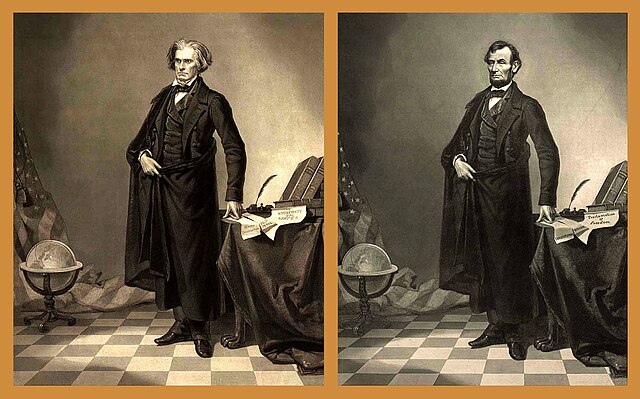Photomontage is the process and the result of making a composite photograph by cutting, gluing, rearranging and overlapping two or more photographs into a new image. Sometimes the resulting composite image is photographed so that the final image may appear as a seamless physical print. A similar method, although one that does not use film, is realized today through image-editing software. This latter technique is referred to by professionals as "compositing", and in casual usage is often called "photoshopping". A composite of related photographs to extend a view of a single scene or subject would not be labeled as a montage, but instead a stitched image or a digital image mosaic.
Photomontage of kiwifruit and lemons, digitally manipulated using GIMP
The Two Ways of Life, a moralistic photo montage of Rejlanders own work, 1857-a choice between vice (at left) and virtue (at right)
Robinson's Fading Away (1858)
Carnival, South End Exhibition Rink, Halifax, Nova Scotia, Canada, February 1899; The carefully prepared photomontage composite was a Notman specialty, each figure being photographed separately and then combined as a single image
Photograph manipulation involves the transformation or alteration of a photograph. Some photograph manipulations are considered to be skillful artwork, while others are considered to be unethical practices, especially when used to deceive. Photographs may be manipulated for political propaganda, to improve the appearance of a subject, for entertainment, or as humor.
Australian photographer Frank Hurley formed this composite photograph from three original negatives of World War I Belgium. Hurley argued with superiors over the ethics of compositing photos, arguing that war was conducted on such a vast scale that it was impossible to capture the essence of it in a single negative.
Lincoln's head superimposed on a print of John C. Calhoun was not discovered for almost a century, when photojournalist Stefan Lorant noticed Lincoln's mole was on the wrong side of his face.
General Grant at City Point is a composite of three different photographs.
Goebbels family portrait photo in which the visage of the uniformed Harald, who was actually away on military duties, was inserted[citation needed] and retouched








![Goebbels family portrait photo in which the visage of the uniformed Harald, who was actually away on military duties, was inserted[citation needed] an](https://upload.wikimedia.org/wikipedia/commons/thumb/c/cc/Bundesarchiv_Bild_146-1978-086-03%2C_Joseph_Goebbels_mit_Familie.jpg/640px-Bundesarchiv_Bild_146-1978-086-03%2C_Joseph_Goebbels_mit_Familie.jpg)